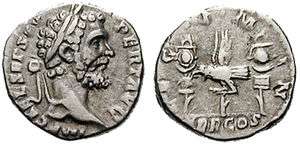Legio I Minervia


Legio I Minervia ("Minerva's First Legion", i.e., "devoted to the goddess Minerva") was a legion of the Imperial Roman army founded in AD 82 by emperor Domitian (r. 81–96), for his campaign against the Germanic tribe of the Chatti. Its cognomen refers to the goddess Minerva, the legion's protector. There are still records of the I Minervia in the Rhine border region in the middle of the 4th century. The legion's emblem is an image of goddess Minerva.
Legio I Minervia first, and main, camp was in the city of Bonna (modern Bonn), in the province of Germania Inferior. In 89, they suppressed a revolt of the governor of Germania Superior. Due to this, Domitian gave them the cognomen Pia Fidelis Domitiana (loyal and faithful to Domitian) to acknowledge their support.
History
Between 101 and 106, the legion fought the Dacian Wars of emperor Trajan, commanded by Hadrian, the future emperor. The emblem with Minerva figure appears on the column of Trajan in Rome, along with symbols of other legions. After this war, I Minervia returned to its home city of Bonna. Together with XXX Ulpia Victrix, stationed close by in Castra Vetera II (modern Xanten), they worked in numerous military and building activities, even extracting stone from quarries.
Although it belonged to the Germanic army and Bonn was its camp, vexillationes (subunits) of the legion were allocated in different parts of the Empire:
- 162–166 war against the Parthian Empire, commanded by emperor Lucius Verus
- 166–175 and 178–180 war against the Marcomanni, commanded by emperor Marcus Aurelius
- 173 campaign against the Chauci of Gallia Belgica, commanded by governor Didius Julianus
- 198–211 garrison of the city of Lugdunum, capital of Gallia
During the civil wars of the late 2nd and 3rd century, I Minervia supported the following emperors (each of them gave them the indicated titles, dropped out after their fall):
- Septimius Severus
- Elagabalus (Antoniniana)
- Alexander Severus (Severiana Alexandriana)
- the Gallic Empire, that existed between 260 and 274
Around 353, Bonna was destroyed by the Franks, and I Minervia disappears from the sources. However, there is no reference to its destruction.
Attested members
| Name | Rank | Time frame | Province | Source |
|---|---|---|---|---|
| Publius Aelius Hadrianus | legatus | c. 103-106 | Germania Inferior | Historia Augusta, "Hadrian", 3 |
| Marcus Pontius Laelianus[1] | legatus | c. 138-c. 141 | Germania Inferior | CIL VI, 1497 |
| Lucius Pullaienus Gargilius[1] | legatus | c. 155-c. 158 | Germania Inferior | CIL III, 7394 |
| Marcus Claudius Fronto[1] | legatus | 162-c. 165 | Germania Inferior | CIL VI, 1377 |
| Gaius Scribonius Genialis[1] | legatus | 166/169 or 177/180 | Germania Inferior | CIL XIII, 12036 |
See also
References
External links
- livius.org account for Legio I Minervia
- (in German) Legio I Minervia Pia Fidelis, German re-enactment group
- , German re-enactment group, reenacting not only the Legio I Minervia.
